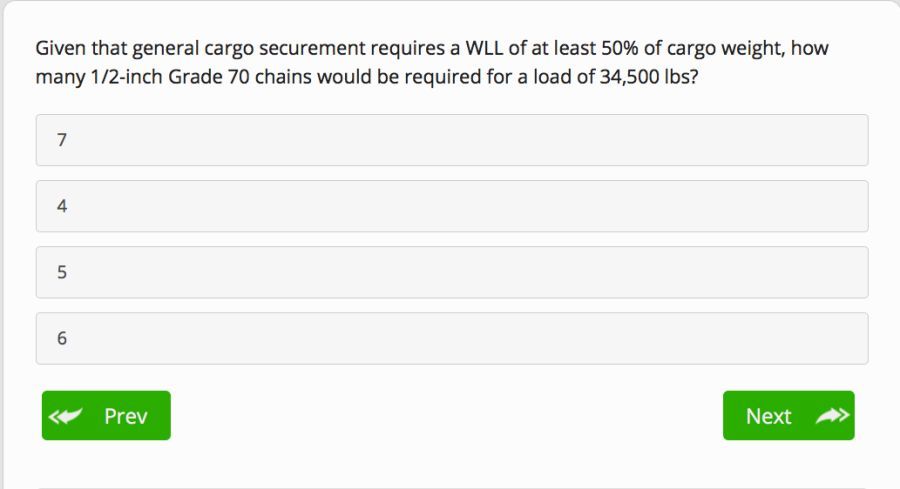Working Load Limit Question
Topic 23184 | Page 1
OK, now that I have rested, I think I may have figured this out. Is it multiplied by 2 to account for the two ends of the chain?

Was there more before the question that could have alluded to the securement method?
If your piece of securement, chain in this instance, goes from the rubrail, to the item being secured, and back to the same side of the trailer, then it is only rated at half of the WLL that it is designed for.
This also applies if the chain goes from the rubrail, directly to the item being secured.
The only time you're piece of securement is rated at its full capacity is if it is attached to both sides of the trailer.
For instance, on a "shotgun" loaded coil, your first 2 pieces of securement should be chains in a horseshoe shape. You attach to the rubrail, go up and through the eye of the coil, and then come back to the same rubrail. So that chain is only qualified as half if it's legal WLL. Once you do the same on the other side of the trailer, you have 2 chains that are both individually half of their own WLL, but that effectively adds up to the WLL of one chain.
Does that make sense? That's the only explanation I have for the question.

The only time your piece of securement is rated at its full capacity is if it is attached to both sides of the trailer.
I hate when I hit submit instead of preview lol
BMI:
Body mass index (BMI)
BMI is a formula that uses weight and height to estimate body fat. For most people, BMI provides a reasonable estimate of body fat. The BMI's biggest weakness is that it doesn't consider individual factors such as bone or muscle mass. BMI may:
- Underestimate body fat for older adults or other people with low muscle mass
- Overestimate body fat for people who are very muscular and physically fit
It's quite common, especially for men, to fall into the "overweight" category if you happen to be stronger than average. If you're pretty strong but in good shape then pay no attention.
Hey Grumpy, I think there are more things to consider when coming up with the proper answer to this question. I'm going to point you in the proper direction in the hopes that you may figure this one out on your own. After all, that is the way you will learn this stuff. 
Here's my tip...
Remember that 50% is the minimum WLL requirement. There are other factors that will increase what is required to properly secure your freight on a flatbed load, such as securing the article of freight against any movement. Think about that diagram in the High Road CDL Training Program where it shows the arrows indicating forward, backward and sideways movement of the article of freight. There are percentages involved in each direction that affect the amount of securement that is required on any given load.
I could be all wet behind the ears here, but I think this may be where you are getting thrown off on this one.
CDL:
Commercial Driver's License (CDL)
A CDL is required to drive any of the following vehicles:
- Any combination of vehicles with a gross combined weight rating (GCWR) of 26,001 or more pounds, providing the gross vehicle weight rating (GVWR) of the vehicle being towed is in excess of 10,000 pounds.
- Any single vehicle with a GVWR of 26,001 or more pounds, or any such vehicle towing another not in excess of 10,000 pounds.
- Any vehicle, regardless of size, designed to transport 16 or more persons, including the driver.
- Any vehicle required by federal regulations to be placarded while transporting hazardous materials.
Haha, while I was working on this there have been other good responses. Chris makes an excellent point. You have got to divide that WLL in half if you are attaching it directly to the cargo or going through an anchor on the freight and back to the same side of your trailer. You mentioned the two ends of the chain, and you may be correct if you are anchoring directly onto the item of freight.
Was there more before the question that could have alluded to the securement method?
If your piece of securement, chain in this instance, goes from the rubrail, to the item being secured, and back to the same side of the trailer, then it is only rated at half of the WLL that it is designed for.
This also applies if the chain goes from the rubrail, directly to the item being secured.
The only time you're piece of securement is rated at its full capacity is if it is attached to both sides of the trailer.
For instance, on a "shotgun" loaded coil, your first 2 pieces of securement should be chains in a horseshoe shape. You attach to the rubrail, go up and through the eye of the coil, and then come back to the same rubrail. So that chain is only qualified as half if it's legal WLL. Once you do the same on the other side of the trailer, you have 2 chains that are both individually half of their own WLL, but that effectively adds up to the WLL of one chain.
Does that make sense? That's the only explanation I have for the question.
In your example, what direction is the eye facing?
This is the entire question:

Another factor that can affect your calculation in all this is the WLL of the anchor points. I realize you didn't give us that information, but it is critical in the real world scenarios. You must always go by the lowest WLL rating listed in any of the combined securement devices and anchor points to come up with an accurate rating. I realize we are straying from your original question, but I'm just pointing the many variable that are sometimes needing to be considered.
I'm going to do some more research on this and find that question. I will get back to you later on this one.
The question seems a little funny if that is all the information given. Even the length of the item being secured could affect the proper answer. Like I said, I will look into this one and get back to ya later.
New Reply:
New! Check out our help videos for a better understanding of our forum features

















Preview:
This topic has the following tags:
Load Securement Truck Equipment Understanding The Laws







 TT On Facebook
TT On Facebook
If the load weighs 34,000 lbs., and I need a WLL of 50% of that, and a 1/2" Grade 70 chain has a WLL of 11,300 lbs., I don't understand how the correct answer was calculated.
You need 3.05 chains, so I rounded up to 4. I don't understand why they multiplied by 2. It seems to me that 7 chains would provide a WLL of 79,100 lbs.
While we are at it, has anyone taken the NY Coil Endorsement, and if so, can you use scrap paper for the math, or do you have to do it in your head?